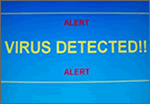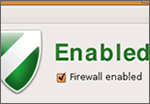|
|
|
|
 |
 |
 > Viruses and Trojans > Antiviruses and Firewalls > Viruses and E-mail dijous, 9 d'octubre de 2008
Computer viruses are programs created in order to cause harm. They enter computers in a variety of different ways and are capable of reproducing themselves and spreading via CDs, the Internet and e-mail.
As with biological viruses, there are many different kinds of computer virus. Some are relatively harmless and do not cause serious consequences. Others, however, are very harmful and can even render the central processing unit (CPU) unusable. In addition, in contrast to what happened in the past, users can be unaware their computer has been infected because viruses often appear as something innocuous. (If a computer is slower than usual, it may be the result of a virus.) This conclusion has come out of a recent study by the Spanish National Institute of Communication Technologies that detected a rise in so-called malicious viruses, such as Trojans and spyware. Last year 80% of household computers in the Spanish State were infected by viruses.
Viruses and Trojans
+ Viruses enter computers in a variety of different ways.
As we said above, there are lots of different kinds of viruses. However, a distinction is sometimes made between viruses and Trojans (also called 'Trojan Horses'). The main difference is that viruses reproduce themselves whilst Trojans do not. Trojans, however, are usually more dangerous and hide in apparently innocuous applications: photos, music files, a screen saver... with the end objective of copying documents and discovering passwords, etc.
Antiviruses and Firewalls
+ A firewall controls communications that enter and leave the computer.
To counter the damaging effects of viruses, antivirus software has been developed. Antivirus software, which can be paid for or free, detects and removes viruses because it knows the code of the virus (its secret number, in other words). Another way to protect a computer is to install a firewall, an application that controls communications that enter and leave the computer in order to detect anomalies.
Viruses and E-mail
+ E-mails are one of the main ways for viruses to enter a computer.
E-mails, especially via attached documents of files, are one of the main ways for viruses to enter a computer. Which is why it is important to be vigilant and to delete messages (without opening them!) that look suspicious for one reason or another: the sender is not known to us, the subject field looks unusual (even if the sender is known to us), or if there is something strange about the names of the attachments, etc.
|
Investiga

> Proves de velocitat, simptomàtiques d'una possible presència de virus.
I també...
- Sistema informàtic: maquinari i programari.
- Sobre el correu brossa, o 'spam'.
- Curiositats sobre virus.
- De virus, troians i cucs.
- Preguntes freqüents sobre virus.
- Correu electrònic i seguretat: els vint-i-cinc errors més comuns.
Portada |
Europa Press |
El Punt |
La premsa |
Especials |
Diari de l'escola |
LesFinances.info |
Editorials |
Mail obert |
Els blocs |
Lletres
Tecnologia i ciència | Solidaritat | Cap de 7mana | Campus | El 9 | Presència | Fòrums | Enquestes | Xat | Correu
Traductor | Edicions en Pdf | Wap-pda | Biblioteca | Lletra més grossa
Tecnologia i ciència | Solidaritat | Cap de 7mana | Campus | El 9 | Presència | Fòrums | Enquestes | Xat | Correu
Traductor | Edicions en Pdf | Wap-pda | Biblioteca | Lletra més grossa
| Què és VilaWeb? Publicitat Mapa web Contacte | Una web de Partal, Maresma i Associats, S.L. |




